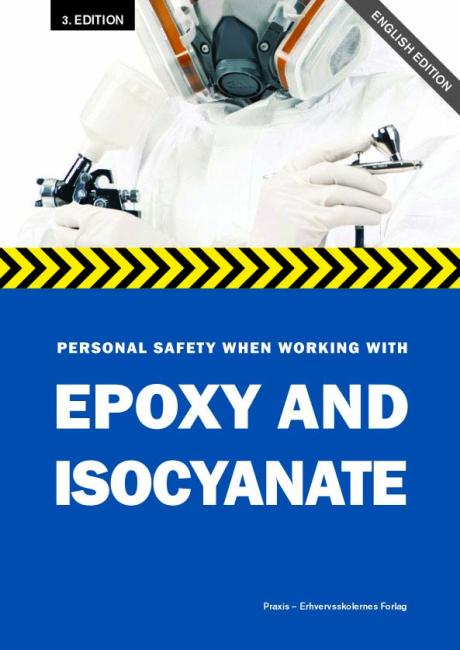
Personal safety when working with epoxy and isocyanates
Når du køber en tidsubegrænset elevlicens, modtager du en aktiveringskode.
Når du køber en tidsubegrænset lærerlicens, modtager du en aktiveringskode.
- Beskrivelse
- Yderligere info
Personal Safety When Working with Epoxy and Isocyanatecovers everything worth knowing about:
- What is epoxy and isocyanates, and where are they used?
- Which health risks are associated with the substances?
- The legislation and regulation of the area, including Danish Working Environment Authority guidelines.
- Rules regarding labelling of products – and how to understand this information.
- Personal protective equipment and its use, including how to correctly put on and remove the equipment.
- How to protect your surroundings.
- Carrying out the work and waste management.
- First aid.
- Safety culture.
The book is specifically targeted for the mandatory training course “Personal Safety When Working with Epoxy and Isocyanates” which is both a labour market training course and a mandatory course in several vocational education programmes. It is a comprehensive educational material for usage in Industriens Arbejdsmarkedsuddannelseskursus No. 47942. The book includes tests, quizzes and practical exercises.
Translation: Marie Pedersen.
Du finder den danske udgave her: Personlig sikkerhed ved arbejde med epoxy og isocyanat
Indhold
Preface
1. Mandatory Training Course
Course Objectives
Requirements to the Course
Prohibition
Exercises
2. Product Knowledge
Historical Background of Epoxy and Isocyanates
Usage
Chemical Composition
Exercises
3. Health Risks
Epoxy Products
Products Containing Isocyanates
Protecting Yourself
Eczema (Dermatitis)
Organic Solvents
Exercises
4. Legislation and Regulation of the Working Environment
The Working Environment Act
Executive Orders
WEA Guidelines
Regulations on Working with Epoxy and Isocyanates
Working Environment Authority
Sector Working Environment Councils
Hierarchy of Controls/Prevention Ladder
Substitution Principle
Rules for Spray Work
Other Regulations of the Working Environment
Exercises
5. Labelling of and Information about Substances and Materials
Labels on Products containing Epoxy and Isocyanates
Substances and Mixtures
REACH
CLP Regulation
Emballering
Storage of Hazardous Substances and Materials
Safe Storage of Toxic Substances
Safety Data Sheet
Workplace Instructions
Limit Values for Substances and Materials
Exercises
6. Protect Yourself
Use of Personal Protective Equipment
Selecting Personal Protective Equipment
Gloves
Eye Protection
Respiratory Protection
Working Clothes
Personal Hygiene
Exercises
7. Protect Your Surroundings
Legislation
Signposting
Personal Hygiene – Protecting your Surroundings
Exercises
8. Carrying Out the Work and Waste Management
Carrying out the Work
Waste management
Work-related Injuries
Exercises
9. First Aid
General First Aid
Emergency Response Plan
Drops and Splashes in Eyes
Drops and Stains on the Skin
Skin Corrosion
Shortness of Breath
Exercises
10. Safety Culture
What is Safety Culture?
Developing the Safety Climate
Behavior and Attitudes
Safe Behavior
Exercises
Glossary
Sources
Index
Forord
Preface
Epoxy and isocyanates possess extraordinary properties in terms of strengths and durability, which is why they are used in many contexts in different products and production processes. However, they belong to the category of hazardous substances and materials, for which there are a number of legal regulations and safety rules. To be able to work with epoxy and isocyanates professionally in a safe and responsible way that protects the safety of yourself and your surroundings, a two-day course (AMU (Labour Market Training Course) course 47942) is required. This is a legal requirement.
This book is specifically targeted for the abovementioned course, and therefore the book carries the same title as the training course: Personal Safety when Working with Epoxy and Isocyanates.
This book covers:
- What is epoxy and isocyanates, and where are they used?
- Which health risks are associated with the substances?
- The legislation and regulation of the area, including Danish Working Environment Authority guidelines.
- Rules regarding labelling of products – and how to understand this information.
- Personal protective equipment and its use, including how to correctly put on and remove the equipment.
- How to protect your surroundings.
- Carrying out the work and waste management.
- First aid.
- Safety culture.
Preface 16th
A lot has happened since the 15th edition of this book was released in 2014. Some of the relevant legislation, regulations and guidelines have been changed and the book has been updated accordingly. However, we have deliberately toned down the references to specific legislation, and instead made endnote references for those who want to read further about the specific law or guideline.
The idea behind this is that students should stay focused on what matters to the safety aspect of the work and not be disturbed by paragraphs and numbers.
Deadlines for various transitional arrangements have been passed, which means that the book, for example, no longer describes the old orange hazard pictograms, or the R and S statements.
An important change since the 15th edition is that the action-oriented learning objectives for the course from The Educational Secretariat for Industry have been tightened and clarified. The objectives and intentions of the new course are dealt with in Chapter 1. One of the points is that there should be more focus on practical skills.
The book provides the theoretical basis to be used in the course, while the practical exercises are organized and carried out at the various course locations.
As a new feature, we have included various tests and suggestions for practical exercises in the chapters where this is relevant. “Test yourself exercises” give students an opportunity to check if they have
understood the most important points from the course. The practical exercises should support the focus on the practical skills. Both tests/exercises and practical exercises are intended as a catalog of deas, which the individual teacher can choose from to complement his or her own instruction material in consideration of the time frame and the specific group of students.
The publisher is very pleased to receive suggestions from the book’s users regarding tests and practical exercises that would be useful to include in future editions of this book.
In addition to being a useful reference book, which is nice to have at hand, even after the course is over, it is now also a personal workbook. It is therefore a good idea if the student writes their name on, for example, the inside of the book cover.
The publisher would like to thank everyone who contributed to this book, and especially Ejnar Als Brix, TECHCOLLEGE, who undertook the sizeable task of giving the book a much needed update.
Praxis
October 2019




